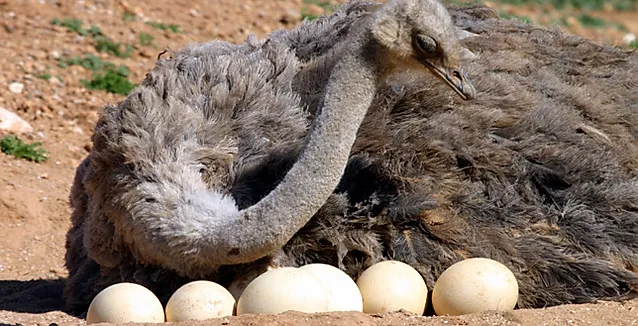Health Benefits of Ostrich Eggs | How do Incubate and Hatch Ostrich Eggs? This article discusses the uses, nutritional value, and production process of the unique and fascinating Ostrich egg.
Learn about the versatility and advantages of this large bird’s egg, including its use as food, as an art and decoration medium, as well as for sports and industrial purposes.
Introduction
The Ostrich egg is a unique and fascinating subject known for its large size, strength, versatility, and unique characteristics. Among all bird species, the ostrich egg is the largest. It weighs up to 3 pounds and measures up to 15 inches in length.
A variety of purposes have been served by ostrich eggs throughout history, ranging from the provision of food to their use of them in art and decoration. Throughout this article, we will discuss the various uses and benefits of Ostrich eggs, as well as their nutritional value and production process.
How Ostrich Eggs are Produced?
The female ostrich can lay up to 60 eggs per year, which is the maximum number of eggs produced by the animal. A nest, usually made of dirt or sand, is used by the birds to lay their eggs.
It takes approximately 42 days for the eggs to hatch after they have been incubated. Parents raise the chicks until they can fend for themselves, protecting and caring for them until they can do so.
Health Benefits of Ostrich Eggs:
A variety of health benefits can be derived from ostrich meat:
- Good Source of Protein:
The Ostrich egg contains a significant amount of protein, which is necessary for building and repairing muscles, maintaining healthy bones, and supporting the immune system.
- Low in Cholesterol:
The cholesterol content of ostrich eggs is also low, which makes them a healthier alternative to chicken eggs for those who are concerned about their cholesterol levels.
- Rich in Nutrients:
Ostrich eggs have a high content of protein, in addition to essential vitamins and minerals such as Vitamin A, Vitamin B12, Vitamin D, iron, and zinc. Nutritional supplements are essential for maintaining good health and preventing a wide range of health problems.
Nutritional Value of Ostrich Eggs:
There are many nutrients and proteins found in ostrich eggs. There is a high level of Vitamin A, Vitamin B12, and Vitamin D present in these foods, as well as minerals such as iron and zinc.
It is estimated that each ostrich egg contains around 6.5 grams of protein, which is about twice the amount of protein found in chicken eggs. The fat and cholesterol content of these products is low as well.
Uses of Ostrich Eggs:
Ostriches are used for a variety of purposes, as follows:
- Food:
The use of ostrich eggs as a source of food dates back centuries. Their rich protein content and essential nutrients make them an excellent source of nutrition for a wide range of dishes.
There are several ways to prepare them, including boiling, frying, or scrambling, and they are commonly used in baking. The equivalent number of chicken eggs is approximately two dozen in an ostrich egg.
- Art and Decoration:
The use of ostrich eggs for artistic and decorative purposes has been practiced for thousands of years. These items were used by the ancient Egyptians to make jewelry and decorative items, as well as by the San people of southern Africa to make bowls and other household items. Lampshades, vases, and ornaments are among the decorative items made from these materials today.
- Sports:
There has been a long history of using ostrich eggshells for making soccer balls and other sports equipment. Using eggshells in these applications is the ideal application due to their strength and durability.
- Industrial Use:
There is also an industrial application for the shells of ostrich eggs. Plastics and other materials can be made with the ground-up seeds, and buttons and beads can be made with them as well.
How do Incubate and Hatch Ostrich Eggs?
The process of incubating and hatching Ostrich eggs requires some patience and expertise but can prove to be a rewarding one. To help you incubate and hatch Ostrich eggs, here are a few tips:
- Incubation: The size of the eggs should be accommodated in an incubator when incubating Ostrich eggs. The eggs should be kept at a consistent temperature of about 99.9 degrees Fahrenheit with a relative humidity level of about 50-55%. Three turns a day are recommended for the eggs.
- Hatching: When the eggs have been incubated for 42 days, they will begin to hatch. Do not disturb the eggs too much during this period and ensure that the temperature and humidity levels remain consistent. It is necessary to keep the chick warm and provide it with food until it is old enough to fend for itself once it hatches.
Conclusion
Several different uses are possible for the Ostrich egg, making it a unique and fascinating subject. The benefits of this plant include providing a rich source of protein and essential nutrients, as well as being used in art and decoration for centuries.
The strength and durability of this material make it suitable for industrial use as well. A female ostrich can lay up to 60eggs per year, which makes it possible for her to produce ostrich eggs.
During the incubation period of approximately 42 days, the eggs hatch into chicks. We hope that this article provides a comprehensive overview of Ostrich eggs, their benefits, and uses, as well as how they are produced.











